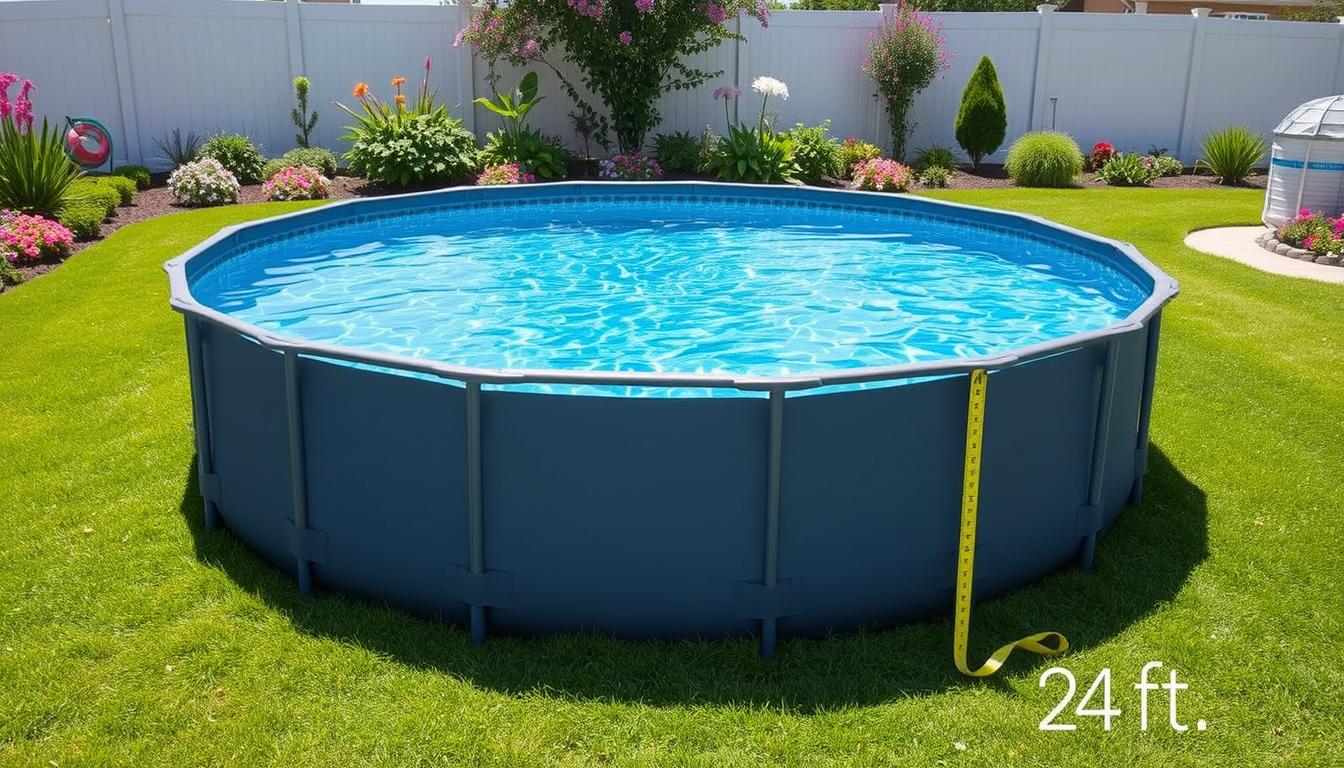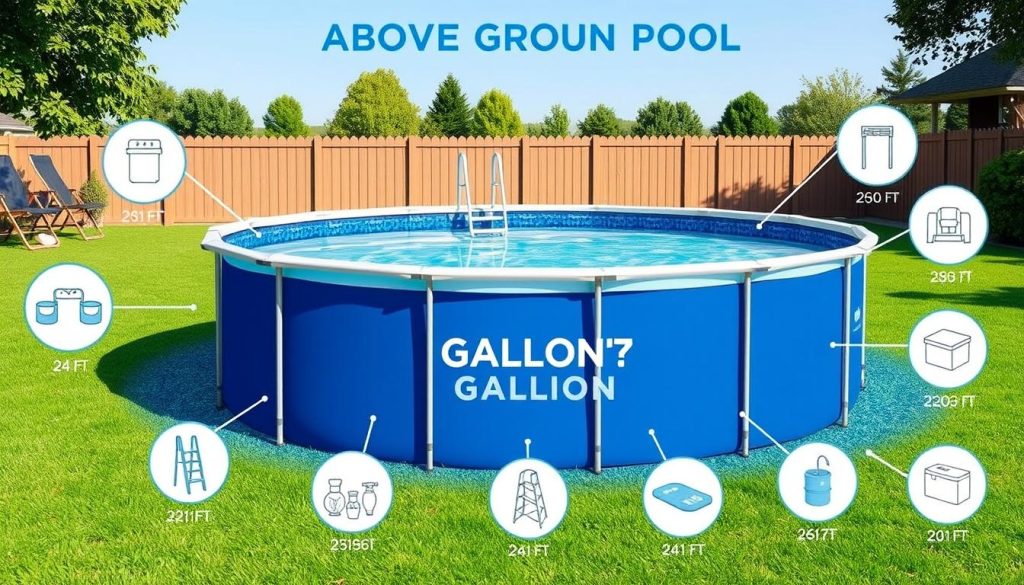
Summer is coming, and many dream of relaxing by their pool. Pool owners often wonder about water volume. This is crucial for 24 ft above ground pools.
Knowing your pool’s capacity helps with initial filling and maintenance. It ensures proper chemical balance for safe swimming all season long.
Let’s explore above ground pool capacity and factors affecting volume calculation. We’ll provide a chart for common pool sizes. You’ll also find tips for maintaining your 24 ft pool.
Get ready for a summer of fun with clear, sparkling water. Let’s dive into the world of pool maintenance together.
Understanding Pool Volume: Why It Matters
Knowing your pool’s size in gallons is vital for safe swimming. It affects chemical balance, filtration, and water quality. Use a pool gallon converter to treat your pool correctly.
Pool volume influences chemical dosage and swimmer capacity. Incorrect estimates can lead to health risks. Consider the number of people using the pool.
Ensuring Safe and Enjoyable Swimming Experience
Pool size determines how many people can swim safely. Larger, deeper pools can accommodate more swimmers. Local regulations often set capacity limits for public pools.
- Larger and more spacious pools can accommodate more people than smaller ones.
- Deeper pools generally allow for more people since the increased water capacity means that contaminants and debris in the pool water are more diluted.
- Around 20 square feet per person are recommended in a pool with a depth of five feet or less, while 15 square feet per person are advisable for a pool with a water depth over five feet.
- Diving boards, water slides, or lazy rivers may impact the pool’s capacity due to the space these features occupy.
- Local building codes and regulations often dictate pool capacity limits.
- The number of certified lifeguards on duty for public pools can affect pool capacity.
Impact on Pool Maintenance and Treatment
Pool volume affects filtration, heating, and chemical treatment. A pool gallon converter helps choose the right equipment. This ensures optimal performance and energy efficiency.
Pool size impacts various plumbing components. These include skimmers, suction lines, pumps, filters, and return jets. Proper sizing is crucial for efficient operation.
- Skimmers are commonly installed on above-ground pools, with some larger pools having multiple skimmers to improve water circulation.
- Suction lines are essential components in a pool’s plumbing system and are usually made of PVC.
- Pool pumps come in various sizes and horsepower to accommodate different pool sizes, with larger pools needing larger pumps.
- Filters help clean and sanitize pool water, removing debris and contaminants.
- Return lines and jets play a crucial role in ensuring proper water circulation in the pool.
- Valves and manifolds are used to regulate water flow within the pool plumbing system.
- Proper placement of returns in a pool can help prevent water stagnation and ensure even water distribution.
- Main drains, typically found at the bottom of the deepest section of a pool, aid in draining water for maintenance purposes.
Understanding pool water needs helps maintain efficient plumbing. It also saves water and energy. Monitor water levels regularly to avoid unnecessary system operation.
Calculating Gallons in a 24 ft Above Ground Pool
Calculating a 24 ft above ground pool’s volume is crucial. It helps with proper maintenance and treatment. Knowing the volume ensures a great swimming experience.
Formula for Round Pools
Round above ground pools use this volume formula:
Volume = π x radius² x depth x 7.48
In this formula:
- π (pi) is a mathematical constant approximately equal to 3.14159
- Radius is half the diameter of the pool
- Depth is the average depth of the pool in feet
- 7.48 is a conversion factor to convert cubic feet to gallons
Real-World Example: 24 ft Round Pool with 52″ Wall Height
Let’s calculate a 24 ft round pool’s volume with a 52″ wall height:
- Radius = 24 ft ÷ 2 = 12 ft
- Depth = 52 inches ÷ 12 inches/foot = 4.33 ft
- Volume = 3.14159 x 12² x 4.33 x 7.48
- Volume ≈ 14,652 gallons
This example shows the pool holds about 14,652 gallons. Knowing this helps with proper maintenance. It’s key for adding the right amount of chemicals.
| Pool Size | Average Depth | Volume in Gallons |
|---|---|---|
| 15′ round | 4 ft | 5,300 |
| 24′ round | 4.33 ft | 14,652 |
| 18′ x 38′ oval | 4 ft | 17,500 |
The table shows how pool size affects water volume. Accurate calculations ensure proper care. This leads to a safe and enjoyable swimming experience.
Quick Reference: Above Ground Pool Gallon Chart
Our chart shows gallon amounts for various above ground pool sizes and wall heights. This pool gallon converter provides easy access to the information you need.

Round Pool Sizes and Corresponding Gallon Amounts
The chart covers common round pool sizes from 12 to 33 feet in diameter. It includes two standard wall heights: 52 inches and 54 inches.
Here’s a quick look at some popular sizes:
| Pool Size (Diameter x Wall Height) | Gallon Capacity |
|---|---|
| 12′ x 52″ | 2,975 |
| 15′ x 52″ | 4,646 |
| 18′ x 52″ | 6,705 |
| 24′ x 52″ | 14,652 |
| 27′ x 52″ | 18,585 |
| 33′ x 54″ | 31,805 |
Oval Pool Sizes and Corresponding Gallon Amounts
Oval pools come in many sizes. Our chart includes popular options such as:
| Pool Size (Length x Width x Wall Height) | Gallon Capacity |
|---|---|
| 12′ x 24′ x 52″ | 5,948 |
| 15′ x 30′ x 52″ | 9,293 |
| 18′ x 33′ x 52″ | 13,594 |
| 21′ x 43′ x 52″ | 20,534 |
| 21′ x 43′ x 54″ | 30,395 |
This above ground pool capacity chart helps you find gallon amounts for your pool size. It ensures accurate water treatment and maintenance for your pool.
How Many Gallons in a 24 ft Above Ground Pool: Practical Implications
Knowing your 24 ft above ground pool’s water capacity is vital for proper maintenance. It affects chemical dosing, water safety, and swimming comfort. Accurate calculations prevent over or under-dosing, which can cause irritation and equipment damage.
Pool water capacity impacts heating and filtration efficiency. A 24 ft round pool with 52″ walls holds about 14,100 gallons. This requires the right size heater and filter for optimal performance.
At Pool Clinics, we help select equipment that matches your pool’s needs. Our goal is to ensure smooth, efficient system operation. This approach saves time and reduces maintenance costs.
Understanding water capacity is key for conservation and cost management. Regular monitoring helps detect leaks early. Prompt action minimizes water waste and keeps utility bills low.
We offer expert guidance on water-saving techniques. Our maintenance services help identify and fix issues quickly. With our support, you can enjoy your pool worry-free.







